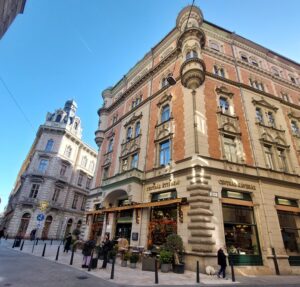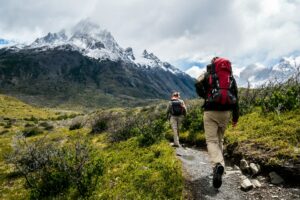Hiking is Great!
After all, you venture out of your home into nature, preferably with company, bringing along delicious food and drinks to enjoy, perhaps devouring them at the first rest stop, just like I did in my childhood by „that” statue on the highway, munching on schnitzel. You expect the weather to be perfect that day, or you only choose this leisure activity when the sun is shining. Indeed, you recharge for a day, then back to the familiar – not necessarily proven – weekdays. During the hike, there were two of you. You (friends and family) and nature.
Pilgrimage is Different!
You don’t necessarily go on schedule (it’s better if you pack a flashlight in your bag), you entrust yourself to the journey. I mean, there may be a destination you want to reach, but you shape and choose the route along the way. If you’ve never been there before, it’s a real adventure; you stop where it feels good, contemplate, heed the inner calls. For spontaneous experiences, you might gladly give up things, step out of your comfort zone, which is not necessarily uncomfortable, thereby paving the way for something. You pay more attention, speak less, a process starts if you allow it and give it space.
Its effect lasts longer than a day, why?
During the pilgrimage, there were three of you. You (friends and family), nature, and your own faith in God. Pilgrimage is an act of spiritual openness, while hiking is not necessarily a spiritual act. If you feel openness, you try it out, thus creating a genuine personal experience about it.
Becoming One with the Activity Pilgrimage
is an individual journey; walking alone allows you to focus all your attention on yourself. Of course, you can find a travel companion whom you have already hiked with, know their habits, reactions, endurance, and, last but not least, their attitude towards pilgrimage.
Pilgrimage presupposes a certain openness, spiritual orientation; during the journey, attention sharpens to every event, person, sign, each of which has symbolic meanings. These symbolic meanings reflect the state, situation in which you find yourself. It’s an opportunity for growth if you let these symbols influence you, open up to them. The ritual of walking, its monotony, is a tool for opening the content of condensed symbols, which sometimes become clearer after the pilgrimage. This is a personal inner spiritual journey. In my individual and group leader journeys so far, I observed that everyone received completely different signs, a separate novel from the same journey. There were times when bird feathers accompanied my path, crocodiles, giant forest rabbits, while my companion encountered galloping deer, rainbow water droplets, etc…This process is aided by transforming your communication with the world. You refrain from everyday trivialities in speech and thought, from emerging criticisms, and from any attitudes that may arouse draining forces within you. And in the spirit of moderation, you give the body what it needs for its basic functioning (clothing, food, sleep) so that their absence does not distract your attention from presence and inner flow.
Which Path Should I Choose?
Wherever you truly feel called, and it comes up repeatedly. What was good for your friend may not be the right path for you. More and more people are choosing to go on a pilgrimage instead of vacationing during their time off; there is a growing demand for inner purification to gain better insight into your life. In addition to the popular Spanish Camino de Santiago, you can also choose Hungarian pilgrimage routes:
– the Hungarian St. James Way, which has been operating for 11 years, is the “busiest” Hungarian pilgrimage route.
– One route starts from Budapest called Camino Húngaro (Budapest-Tata-Pannonhalma-Lébény-Pozsony-Wolfsthal), 282 km,
– the other starts from Tihany called Camino Benedictus (Tihany-Bakonybél-Pannonhalma-Lébény-Pozsony-Wolfsthal), 241 km.
Both routes lead to a sacred destination, touching on Hungary’s most prominent St. James sanctuary, through Lébény.
– the north-south Hungarian Camino from Esztergom to Máriagyüd
-the Balaton Camino,
– the Way of Pearls (Via Margaritarum), sections between Budapest and Mátraverebély-Szentkút (180km) and continuing from Mátraverebély-Szentkút to Máriacell (760km), marked with white circles with 10 yellow dots.
The spiritual arc of this route is given by the historical and sacred places along the route, as well as the contemplative prayer beads called “pearls of life”.
– but you can also choose Marian routes, St. Martin’s or St. Elizabeth’s routes,
– Pauline routes, star paths, or any sacred geography.
Some of these are not necessarily from the world of rationality, seen from another perspective, they are less known.
– currently under development is the newest St. James Way, the Via Pannonia, over 400 km long from Budapest in a southwest direction to the endpoint of the Slovenian Jakobova Way, this route will also join the Camino, but you can also divert from it to Rome.
How Many Days is a Pilgrimage?
If you are open to change, it doesn’t matter; obviously, the misconceptions of 40 years may not be cleared up in 4 hours, but you can gain insight. The process can happen quickly: you cleanse, then recognize what is happening, become aware, so the pilgrimage continues – ideally – in everyday life as well.
And what remains for the weekdays?
Pilgrimages may have the added benefit of initiating changes in your life, but that is not their primary purpose. We often fear change because it is not voluntary; it is unexpected and disrupts the familiar. Our makeshift, outdated constructs will eventually crumble, but it matters how much time we spend in such unproductive situations. Of course, they will collapse on their own over time, and pilgrimages catalyze this process. Change always brings positive clarity, insight, and reconsideration in retrospect.




